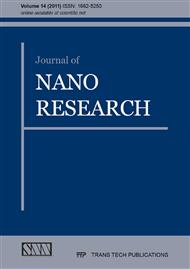[1]
Information on http: /www. metalmundi. com/si/site/1265?idioma=portugues. April 15th, (2010).
Google Scholar
[2]
B.D. Cullity, C.D. Graham. Introduction to Magnetic Materials, 2 Ed, Wiley-IEEE Press. (2008).
Google Scholar
[3]
Constantine A. Balanis. Antenna Theory: Analysis and Design, 2Ed, Wiley & Sons. (1996).
Google Scholar
[4]
Donald R.J. White, Michel Mardiguian. Electromagnetic Shielding. Gainesville. Virginia. (1988).
Google Scholar
[5]
K.S. Bhat, S.K. Datta, C. Suresh. Electrical and Microwave Characterization of Kanthal Thin Films: Temperature and Size Effect, Thin Solid Films, 332, pp.220-224. (1998).
DOI: 10.1016/s0040-6090(98)01103-1
Google Scholar
[6]
Hong Qui, Fengping Wang, Ping Wu, Liqing Pan, Lingyu Li, Liangyon Xiong, Yue Tian. Effect of Deposition Rate on Structural and Electrical Properties of Al Films Deposited on Glass by Electron Beam Evaporation, Thin Solid Films, 414, pp.150-153. (2002).
DOI: 10.1016/s0040-6090(02)00454-6
Google Scholar
[7]
Xuedong Bai, Meng Chen, Lishi Wen. Size Effect of Electromagnetic Constitutive Characteristics of Ultrathin Al Films, J. Mater Sci. Technol., Vol. 16, Nr5, (2000).
Google Scholar
[8]
M. Carbucicchio, C. Grazzi, M. Rateo, G. Ruggiero, M. Solzi. Size-Dependent Magnetic Properties in Fe/Al Multilayers, Journal of Magnetism and Magnetic Materials, pp.563-565. (2000).
DOI: 10.1016/s0304-8853(00)00222-5
Google Scholar
[9]
S.M. Shivaprasad, M.A. Angadi. The Effect of Deposition Rate on the Electrical Resistivity of Thin Manganese Films, J. Phys. D.: Appl. Phys, 13, p L157-L159. (1980).
DOI: 10.1088/0022-3727/13/8/003
Google Scholar
[10]
F. Warkusz. Size Effect in Metallic Films, Electrocomponent Science and Technology, Vol. 5, pp.99-105. (1978).
DOI: 10.1155/apec.5.99
Google Scholar
[11]
C.R. Tellier. Size Effect in Metallic Films, Electrocomponent Science and Technology, Vol. 5, pp.127-132. (1978).
Google Scholar
[12]
M. Cattani, A.R. Vaz, R.S. Wiederkehr, F.S. Teixeira, M.C. Salvadori, I.G. Brown. I nfluence of Electron Scattering From Morphological Granularity and Surfece Roughness on Thin Film Electrical Resistivity, Surface Review and Letters, Vol. 14, Nr01, pp.87-91. (2007).
DOI: 10.1142/s0218625x07009116
Google Scholar
[13]
Ramo, Simon;. Whinnery, John R e Duzer Theodore Van. Campos e Ondas em Eletrônica das Comunicações, Ed. Guanabara Dois, (1981).
Google Scholar
[14]
R. Olmi, M. Tedesco, C. Riminesiand, A. Ignesti. Thickness-Independent Measurement of the Permittivity of Thin Samples in the X Band. Journal of Measurement Scince Technology. (2002).
Google Scholar
[15]
Samuel M. L. da Silva, Carlos L. Ferreira. Análise Segundo Modelo F-S e Experimental da Resistividade de Filmes Finos de Alumínio Obtidos por Evaporação Resistiva por Feixe de Elétrons. XI Simpósio de Guerra Eletrônica. São José dos Campos – SP. (2009).
DOI: 10.5151/1516-392x-30493
Google Scholar
[16]
Kanthal. Kanthal Handbook (catalogue 1-A-5B 03. 09. 2001 5000). Sweden. (2001).
Google Scholar
[17]
B. Ya. Zeldovich, A. E. Kaplan. Free-Space Terminator and Coherent Broad-Band Black-Body Interferometry, Optical Society of America, IEEE. (2006).
DOI: 10.1109/cleo.2006.4627943
Google Scholar
[18]
Jong-Hyun Jeong, Sun-Hong Kim, Ji Hyun Min, Young Keun Kim, Sung-Soo Kim. High Frequency Noise Absorbing Properties of Nickel Nanowire Arrays Prepared by DC Electrodeposition, Phys. Stat. Sol. (a) 204, Nr 12, 4025-4028. (2007).
DOI: 10.1002/pssa.200777375
Google Scholar
[19]
Weidong Li, Yuqin Sun, Charles R. Sullivan. High-Frequency Resistivity of Soft Magnetic Granular Films, IEEE Transactions on Magnetics, Vol. 42, Nr 10. (2005).
DOI: 10.1109/tmag.2005.854720
Google Scholar
[20]
V. Korenivski. GHz Magnetic Film Inductors, Journal of Magnetism and Magnetic Materials, 215-216, pp.800-806. (2000).
DOI: 10.1016/s0304-8853(00)00292-4
Google Scholar
[21]
A.V. Osipov, I.T. Iakubov, A.N. Lagarkov, S.A. Maklakov, D.A. Petrov, K.N. Rozanov, I.A. Ryzhikov. Multi-Layered Fe Films for Microwaves Applications, PIERS 2007, Prague, Czech Republic, August 27-30. (2007).
DOI: 10.2529/piers070320070112
Google Scholar
[22]
Gi-Bong Ryu, Sung-Soon Kim. Numerical Analysis on Power Loss Mechanism of Fe55Al18O27 Thin Films for Conduction Noise Through Microstrip Line, Journal of Applied Physics, pp.105-107, (2009).
DOI: 10.1063/1.3068014
Google Scholar
[23]
Sondheimer, E. H. The mean free path of electrons in metals. Advances in Physics 1, 1-39. (1952).
Google Scholar


